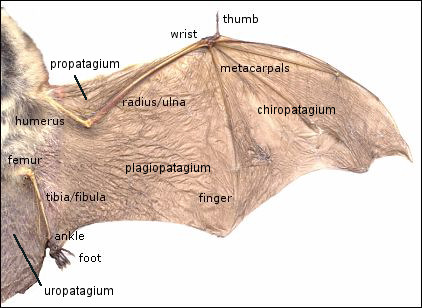

Everyone seems to put down jargon, but let's face it: in many circumstances, we really couldn't do without it. Even people who sneer at pointed-headed intellectuals think nothing of using sports jargon that is as murky as Sanskrit to the uninitiated.
So let's explore a little jargon that goes with bats. You may already know that the formal name of the bats is Chiroptera, meaning "hand wing". And that, of course, is apt, because the major part of the wing is made up of the hand with its greatly elongated fingers. How about patagium, which has come to mean a membrane or fold of skin. Bats have a chiropatagium covering the hand, a propatagium in front of the angle of the elbow, a plagiopatagium connecting hand with body and leg, and a uropatagium connecting legs and tail. The "chiro" part, for "hand", you already know, "pro" means "in front of', "plagio" means "oblique", and "uro" is "tail".
You're now equipped to amaze and confound all the powers that be at
your next cocktail party!

Listen to the Audio (mp3 format) as recorded by KTEP, Public Radio for the Southwest.
Contributor: Arthur H. Harris, Laboratory for Environmental Biology, Centennial Museum, University of Texas at El Paso.
Desert Diary is a joint production of the Centennial Museum and KTEP National Public Radio at the University of Texas at El Paso.

Labeled structures of the wing and posterior region of a bat.